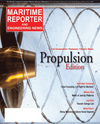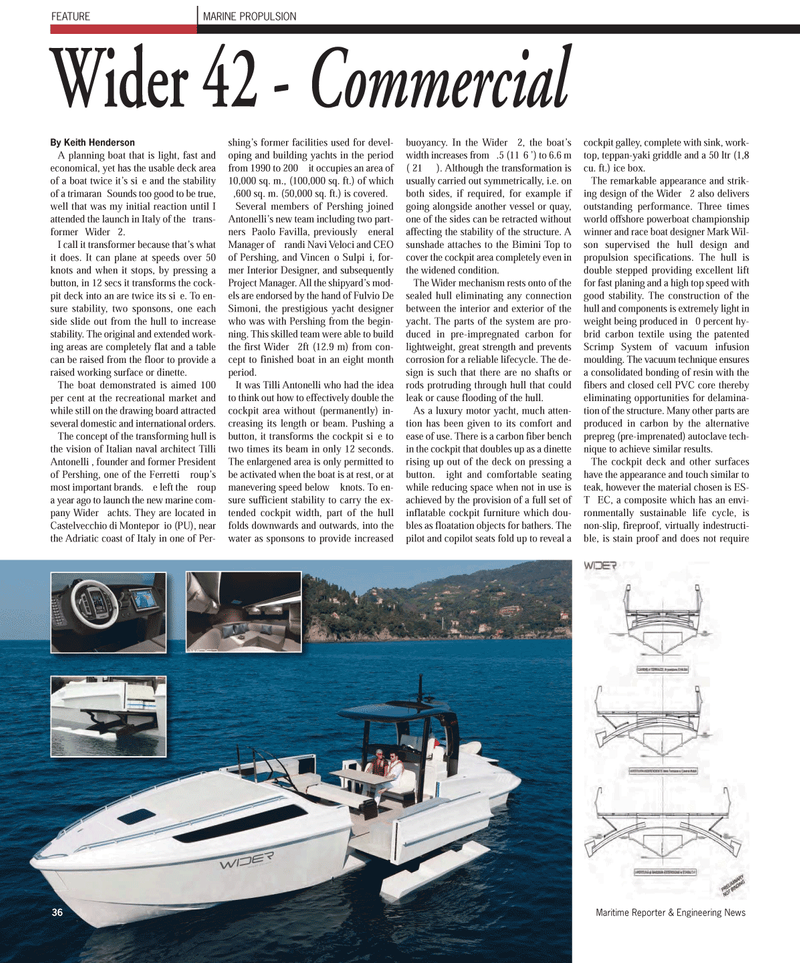
Page 36: of Maritime Reporter Magazine (September 2011)
Marine Propulsion Annual
Read this page in Pdf, Flash or Html5 edition of September 2011 Maritime Reporter Magazine
By Keith HendersonA planning boat that is light, fast and economical, yet has the usable deck areaof a boat twice it?s sie and the stability of a trimaran Sounds too good to be true, well that was my initial reaction until I attended the launch in Italy of the trans- former Wider 2. I call it transformer because that?s what it does. It can plane at speeds over 50 knots and when it stops, by pressing abutton, in 12 secs it transforms the cock- pit deck into an are twice its sie. To en- sure stability, two sponsons, one each side slide out from the hull to increasestability. The original and extended work- ing areas are completely flat and a tablecan be raised from the floor to provide a raised working surface or dinette. The boat demonstrated is aimed 100per cent at the recreational market and while still on the drawing board attracted several domestic and international orders. The concept of the transforming hull isthe vision of Italian naval architect Tilli Antonelli , founder and former Presidentof Pershing, one of the Ferretti roup?s most important brands. e left the roup a year ago to launch the new marine com- pany Wider achts. They are located in Castelvecchio di Monteporio (PU), near the Adriatic coast of Italy in one of Per- shing?s former facilities used for devel- oping and building yachts in the period from 1990 to 200 it occupies an area of 10,000 sq. m., (100,000 sq. ft.) of which,600 sq. m. (50,000 sq. ft.) is covered. Several members of Pershing joined Antonelli?s new team including two part- ners Paolo Favilla, previously eneral Manager of randi Navi Veloci and CEO of Pershing, and Vinceno Sulpii, for- mer Interior Designer, and subsequently Project Manager. All the shipyard?s mod- els are endorsed by the hand of Fulvio DeSimoni, the prestigious yacht designerwho was with Pershing from the begin- ning. This skilled team were able to build the first Wider 2ft (12.9 m) from con- cept to finished boat in an eight month period.It was Tilli Antonelli who had the idea to think out how to effectively double the cockpit area without (permanently) in-creasing its length or beam. Pushing abutton, it transforms the cockpit sie to two times its beam in only 12 seconds. The enlargened area is only permitted to be activated when the boat is at rest, or at manevering speed below knots. To en- sure sufficient stability to carry the ex- tended cockpit width, part of the hullfolds downwards and outwards, into the water as sponsons to provide increased buoyancy. In the Wider 2, the boat?s width increases from .5 (11 6?) to 6.6 m ( 21 ). Although the transformation is usually carried out symmetrically, i.e. on both sides, if required, for example if going alongside another vessel or quay, one of the sides can be retracted withoutaffecting the stability of the structure. A sunshade attaches to the Bimini Top to cover the cockpit area completely even in the widened condition. The Wider mechanism rests onto of the sealed hull eliminating any connection between the interior and exterior of the yacht. The parts of the system are pro- duced in pre-impregnated carbon for lightweight, great strength and prevents corrosion for a reliable lifecycle. The de- sign is such that there are no shafts orrods protruding through hull that couldleak or cause flooding of the hull.As a luxury motor yacht, much atten-tion has been given to its comfort and ease of use. There is a carbon fiber bench in the cockpit that doubles up as a dinetterising up out of the deck on pressing abutton. ight and comfortable seating while reducing space when not in use isachieved by the provision of a full set of inflatable cockpit furniture which dou-bles as floatation objects for bathers. The pilot and copilot seats fold up to reveal a cockpit galley, complete with sink, work- top, teppan-yaki griddle and a 50 ltr (1,8cu. ft.) ice box.The remarkable appearance and strik-ing design of the Wider 2 also delivers outstanding performance. Three times world offshore powerboat championship winner and race boat designer Mark Wil- son supervised the hull design andpropulsion specifications. The hull is double stepped providing excellent lift for fast planing and a high top speed with good stability. The construction of the hull and components is extremely light in weight being produced in 0 percent hy- brid carbon textile using the patented Scrimp System of vacuum infusion moulding. The vacuum technique ensures a consolidated bonding of resin with thefibers and closed cell PVC core thereby eliminating opportunities for delamina-tion of the structure. Many other parts are produced in carbon by the alternative prepreg (pre-imprenated) autoclave tech- nique to achieve similar results. The cockpit deck and other surfaces have the appearance and touch similar to teak, however the material chosen is ES- TEC, a composite which has an envi- ronmentally sustainable life cycle, is non-slip, fireproof, virtually indestructi- ble, is stain proof and does not requireWider 42 - Commercial FEATURE MARINE PROPULSION36Maritime Reporter & Engineering News

 35
35

 37
37
